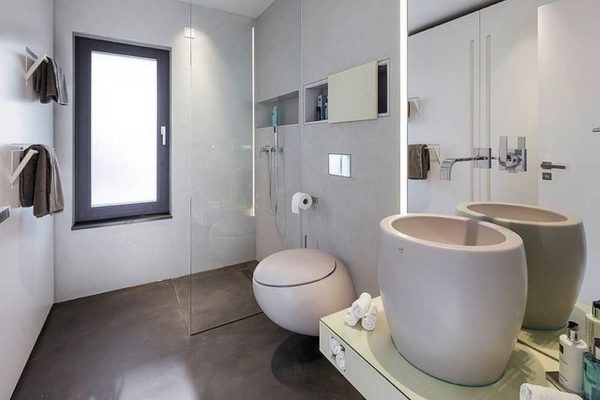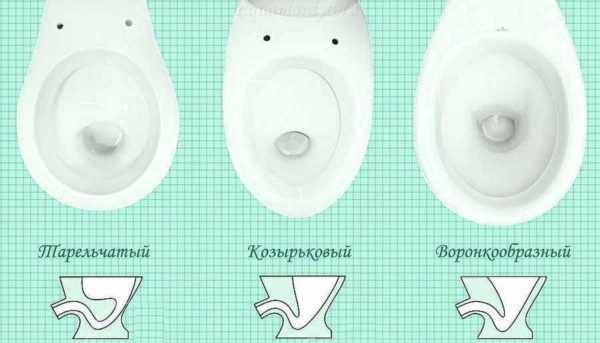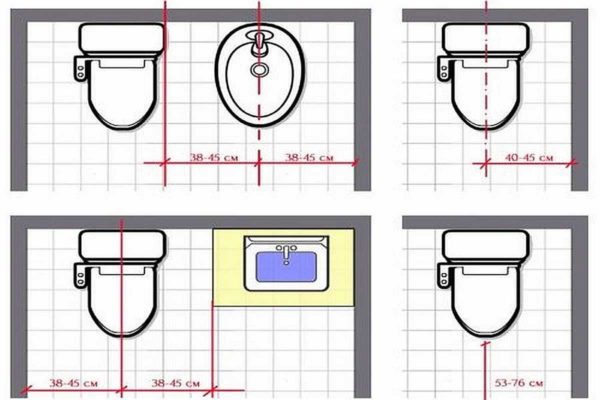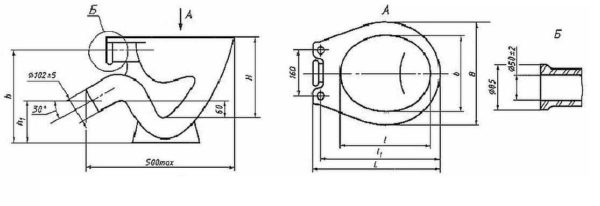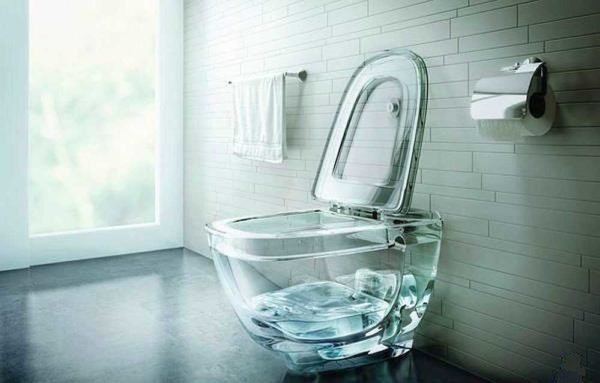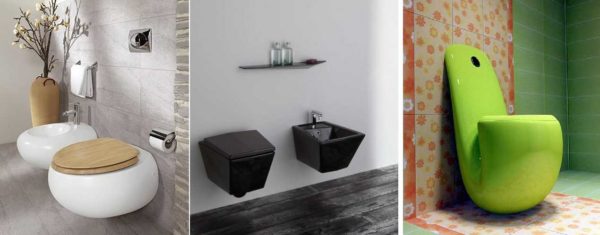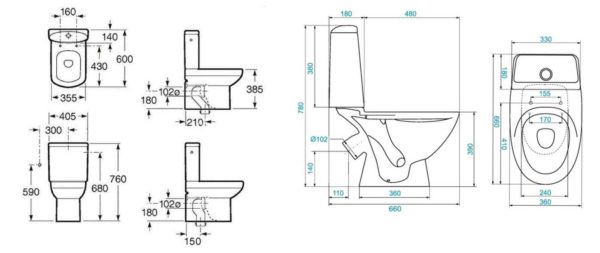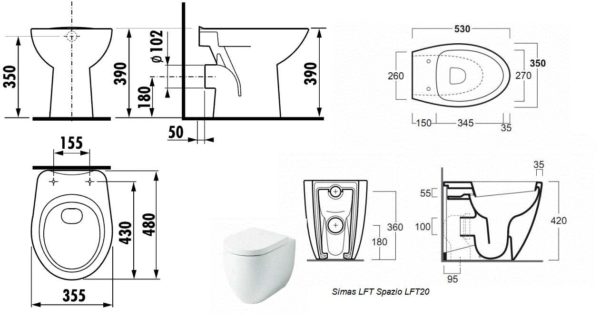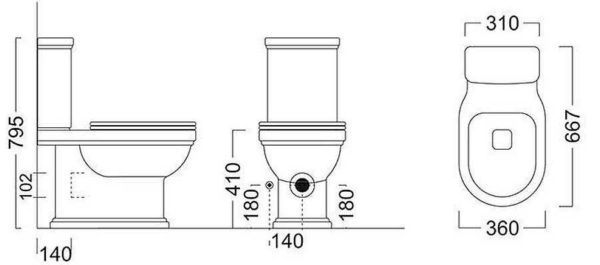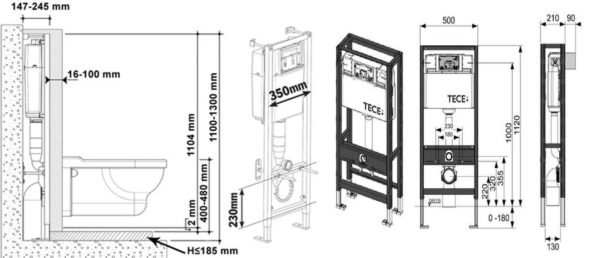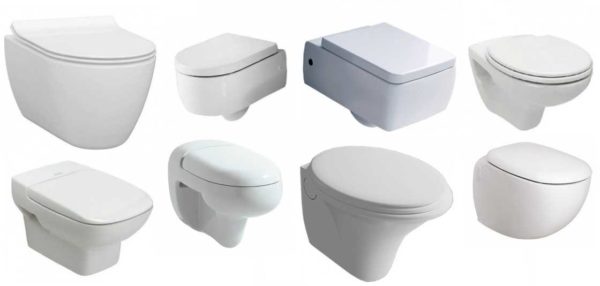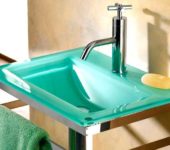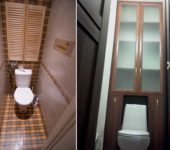Dimensions of the toilet bowl floor-standing, hanging, angular
The bathroom is one of the most visited places in our house. So its arrangement is a very important thing. First of all, you should choose a toilet. It's easier to focus on standard sizes. You can find suitable models for almost every taste.
The content of the article
Types and design features
The dimensions of the toilet bowls depend on the design. So you need to familiarize yourself with them. At the same time, we will find out which types can be installed in small bathrooms.
Bowl shape
The type of toilet bowls by drain or bowl shape determine the ease of use and the level of "aromas" that can be. Also, the minimum and maximum sizes depend on the shape. There are three types of bowls or sinks:
- Poppet or with a shelf. The drain is shifted closer to the front wall, and the bowl has a protrusion, which someone calls a shelf, and someone calls a plate. Hence the name of the form. With such a device, there will be splashes when draining, which is unpleasant, but at least you will not feel them. However, a toilet bowl with a shelf is the most "fragrant" one. The excrement remains "on the shelf" until it is washed off, so the smell is intense.
- Visor. The drain is also closer to the front wall, but the back wall of the bowl is even, with a slight slope towards the drain funnel. With this design, the waste enters the rear wall and slides down into the water. There is no splash, the smell is present, but not as intense. Traces remain, even though the main source is in the water.
- Funnel-shaped. The shape of the bowl of such a toilet is similar to an ordinary funnel. Draining almost in the middle. There will be almost no smell, but you will feel the splash on yourself. Literally. You can fight splashes either by moving forward / backward, as the dimensions allow (yours and the toilet bowl), or by throwing a piece of toilet paper into the water.
Which toilet is better to choose? In general, a good visor. No splashes, with a tolerable level of "flavor". True, after each use you will have to use a brush. But you quickly get used to this procedure.
Installation method
According to the installation method, there are two types of toilet bowls: floor-standing and suspended. With the floor-standing ones, everything is clear, they are installed on the floor and fixed to it. They are of two types. The first one is familiar to us with a tank on a portable shelf or with a tank on the wall. The second type is wall-mounted. We have this option recently. It differs in that the back wall is almost completely parallel to the wall.
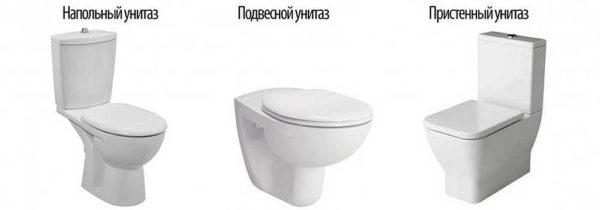
Most toilets are floor-mounted. There are conventional models and wall-mounted. There are also suspended ones. They need a special frame, which is hidden behind a false wall. This frame is called installation.
A suspended or built-in toilet is not attached to the wall, as it might seem, but to a structure that is hidden behind a false wall. This design is called "installation". It is a metal frame that is bolted to the walls and to the floor. And already on this frame is attached not only the bowl, but also the button, and all the pipes.
Release
These are not all design features. We still need to deal with the issue. This is the outlet through which the toilet is connected to the sewer. The most compact models with a vertical outlet. The longest ones are oblique. But it is they who are more common, since it is not necessary to raise the sewer pipe, but you can only put a tee and insert a corrugation into it.
There are also three forms of toilet outlets: straight, oblique and vertical. Vertical ones are now very rare, although you can find them if you wish. This standard is used in America. But everything is possible on order.It is the toilets with vertical outlet that will have, by the way, the smallest "depth". And with this release, wall models are usually made.

The outlet of the toilet is its outlet. They are of three types: straight (horizontal), oblique and vertical
How to choose a toilet by release? If you just change the toilet, and you do not plan to remodel the sewer, there is actually no choice. You need one with the same release that was. No options. When replacing sewer pipes in an apartment, it will be possible to change a slant to a straight line, or vice versa - a straight line to a slant. But it will not work to put a vertical one - the drain should go vertically down, that is, to your neighbors below. This means that you will have to make a replacement for them too. When should you choose a vertical drain? In a private house, it is better on the ground floor. In an underground or basement, the pipe will not interfere with anyone. A plus of this type has already been announced - this is the minimum "depth".
Types of cisterns for the toilet
Before you deal with the standard dimensions of the toilet, you must also think about the type of cistern. This also affects the size. For example, the popular compact model is far from the "shortest" one. There is a palm tree for models with a separate wall-mounted tank. But we must also take into account the pipe with which the cistern and the toilet are connected.
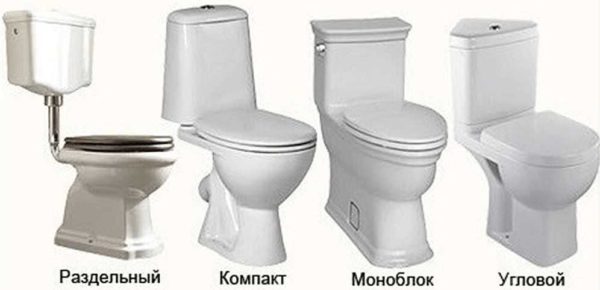
Toilet cisterns also affect the size. Often they are either an integral part or cast in a single mold.
In general, there are three types of toilet cisterns: separate (wall-mounted), compact and monoblock. Compact and monoblock can be straight or angled. Corner models are usually the smallest. And it is they who definitely allow you to save space in small toilet.
What are the differences between cisterns? There is no fundamental difference. It's about the preferences of the owners, well, and in appearance. Monoblock - this is when the bowl and the tank are molded in a single shape and cannot be separated. Compact is when the tank is installed on the back of the bowl. In such models, the bowl has a special outlet at the back with holes for attaching the bowl. Why is this option good? You can change the tanks. Not only if the old one cracked, but also if you missed the shape or volume. This also happens. Wall mounted cisterns have the same pluses. The only difference is that you have to fix them and install a connecting pipe.
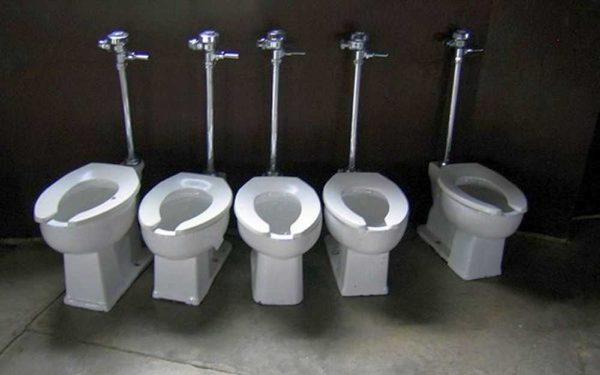
The smallest installation space is required under the Drukspühler. This is a flushing system without a cistern
By the way, there are toilets without cisterns. These are not the ones that have them hidden in the installation, but those that are directly connected to the water supply. This model is used in Germany, and we also have it in some public toilets. Its main advantage is space saving. Whatever one may say, but the tank takes up space. If the space is very bad, you can put this one. True, provided that there is enough pressure for it to work in your system.
Distances
Good for those who have a large room for a bathroom or toilet. If it is not so large for you, you need to know the minimum tolerances for the distance from the toilet bowl to nearby "structures" and devices.
- There must be at least 25 cm between the bidet and the toilet.
- There should be at least 60 cm of free space in front. That is, the distance from the edge of the bowl to the door or wall in front is 60 cm or more.
- There should be a free space of at least 25 cm on the sides. This is not enough, but bearable. Comfortable distance 35 cm.
Now you draw a plan of your bathroom, mark the minimum distances and see what size the toilet will fit into your toilet. So everything is simple.
Standard Toilet Sizes and Minimum Toilet Sizes
GOST 30493-96 standardizes the size of only toilets with a shelf. There are also those that are installed in cars, but we do not need them. The standard sizes of a toilet bowl with a shelf are prescribed for two options: with a solid cast and with an added one. The second model is used with or without wall-mounted cisterns. There are also standard sizes of a children's toilet. They (for children) go without a shelf. All dimensions are shown in the table.And to understand what we are talking about, we look at the drawings.
| Toilet bowl design | H | h | h1 | l | l1 | L (depth or length) | b | B (width at widest point) |
|---|---|---|---|---|---|---|---|---|
| With one-piece cast shelf for tank installation (Compact) | 150 | 330 | 435 | not less than 605 (maybe 575 mm) | 260 | 340 and 360 | ||
| Without shelf (hinged tank) | 370 and 400 | 320 and 350 | 460 | |||||
| Child | 335 | 285 | 130 | 280 | 380 | 405 | 210 | 290 |
So, the standard size of a toilet bowl with a shelf (usually called "Compact"):
- Length - L - 605 mm. This is taking into account the fact that the model is compact with a protrusion for installing a tank. It is separately spelled out that it is possible to produce shorter models up to 575 mm in length.
- Width - B - also two standard values: 340 and 360 mm.
The height of the toilet bowls is not standardized, but usually in the range of 370-390 mm. So according to the standard, the narrowest toilet bowl is 340 mm, and the shortest model "compact with shelf and oblique drain" - 575 mm. Based on these values and the minimum allowable distances from the previous paragraph, we can determine the minimum dimensions of the toilet for the installation of such a model. Let's start by calculating the width: 340mm + 2 * 250mm = 840mm. That is, the distance between the walls cannot be less than 84 cm. Better, of course, more.
And the length of the toilet should be 575 mm + 600 mm = 1175 mm. But this is without taking into account the fact that it is still necessary to lay the sewer pipe and somehow connect the drain. We will allocate another 20 cm for this. In total, we get that the minimum length of the toilet room is 1175 mm + 200 mm = 1375 mm. In meters it is 1.375 m.
The standard dimensions of a toilet bowl with a wall-mounted cistern are significantly smaller: length / depth 460 mm, width 360 mm and 340 mm. That is, the room can be shorter. Its minimum depth is 1060 mm - this is only for a comfortable installation of the bowl, but you also need to connect pipes, so add another 20 cm.Total, we get that to install a toilet bowl with a wall-mounted cistern, the room must be at least 126 * 84 cm. if your room is longer, you can push the miracle of plumbing back, and behind the toilet and / or above it make a cabinet with shelves.
What sizes are toilets
The standard sizes of the toilet are designed for people of average height and build. Not all are like that. And a toilet with a shelf, which is described in the GOST, is far from the best choice in terms of aromas. And also, most of the imported products are in stores today. And they have their own standards. For example, the European standard size of the toilet is 680 * 360 * 400 mm (this is the length, the width at the widest part and the last digit is the height). The Americans have gone even further - their usual "depth" is 768 mm, width 380 mm, the height of the rim above the floor is still the same - 36-38 cm. As you can see, the standards are different, and not everything is done according to the standards. People have different needs and the market tries to satisfy them.
Dimensions of floor models
As you can imagine, floor-standing toilet bowls are different and their sizes are also different. We give a range, but we do not guarantee that there are no narrower or wider ones. Most likely, if you set a goal, you can find both.
Compact
The Compact type toilet (with a cistern, which is mounted at the back) has the following dimensions:
- length - 610-645 mm;
- width from 345 mm to 420 mm;
- height from 370 mm to 395 mm.
Note that the narrowest bowls look more like a rectangle. They are not as round as we are used to. They are quite convenient to use. There can only be problems when buying a cover. This form is rare.
Without tank
A toilet without a shelf with a hinged or separate cistern has the following dimensions:
- length 435-460 mm (20 cm less than Compact models!);
- width 360-400 mm;
- rim height from floor level 350-390 m.
As you can see, they are more compact, despite the name given to the previous version. But such models are less popular, since the tank needs to be fixed, and this is an additional headache. And earlier this type was considered a "relic", now it is stylish and interesting.There are very interesting models (however, they are interesting).
Monoblock
There are also floor standing toilets Monoblock. They are mostly wall-mounted. These are those in which the tank and bowl are integral and one is a continuation of the other. The sizes of Monoblock toilets are as follows:
- length - 665-720 mm;
- width (usually the tank is wider, but not always) - 360-420 mm;
- height
- from the floor to the top of the lid - 700-870 mm;
- from the floor to the rim of the bowl - 360-390 mm.
These models cannot be called small. Perhaps that is why they are not very popular with us. Whatever one may say, it is easier to bring in a separate bowl and a tank than the entire assembly. But the likelihood of leakage is less.
Pendant model sizes
For wall-hung toilet bowls, you need to look at the dimensions of the bowl itself and the installation. They are usually included. And, as a rule, more questions arise with the installation. Actually, the size of the installation depends on the planned load. External insecurity and fragility are deceiving. A suspended toilet with a reinforced frame can withstand a weight of up to 400 kg, standard designs up to 200 kg, and super strong ones up to 400 kg.
The sizes of installations for wall-hung toilet bowls are as follows:
- height - 1100-1250 mm;
- width 400-550 mm;
- depth - 140-250 mm.
These are average values. There are also narrow installations - they can be from 345 mm. True, their "carrying capacity" is about 120-150 kg. And those that are found, most often about 50 cm wide. As you can see, they do not take up too much space.
Now about the size of the bowl of hanging toilet bowls. It has the following dimensions:
- length 480-560 mm;
- width 356-430 mm.
The height of a wall-hung toilet bowl can be different. Depends on the style. There are bowls that are almost flat, 290-320 mm high, and there are medium ones - 340-365 mm. Moreover, they look very different: square, round, oval, narrowed to the bottom or rounded, more like a washer.
There may still be questions about how high to place the built-in toilet bowl relative to the floor. No worries. The height will be "selected" automatically. It will depend on the size of the bowl and the location of the hole for the sewer outlet in the installation. You just need to make sure that they are compatible (the same size and that the bottom of the bowl does not "lie" on the floor).

